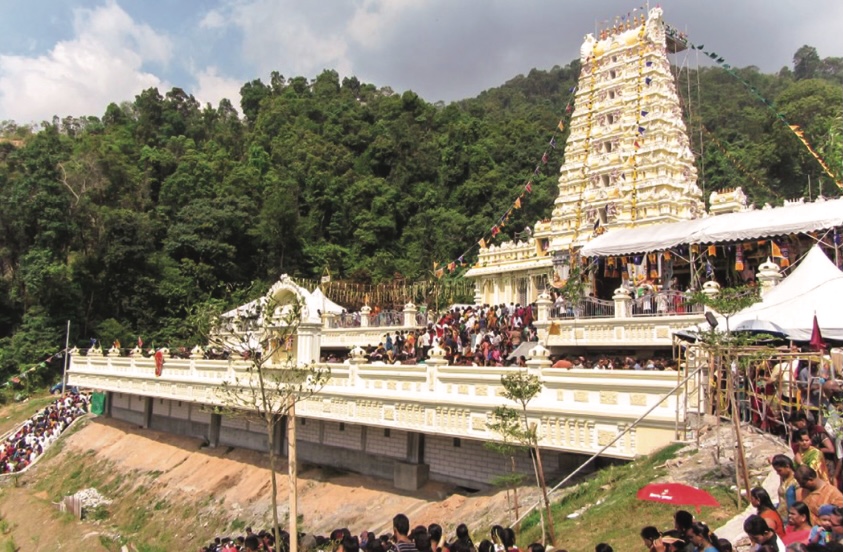TEMPLE BUILDING
FORTY PRIESTS BRING TWELVE-YEAR PROJECT TO COMPLETION
Former temple chairman and surveyor, P. Kuvenaraju, a key figure in the new temple’s construction, provides an account of the building process.
THE NEW SITE FOR THE TEMPLE was a hilly area full of rocks. Despite this huge challenge, everyone wanted to work for the project. Starting with land clearing in 2000, we had to do a lot of rock blasting, cutting and filling. Site preparation alone took six years. Though the work was slower than we hoped, there were unusual positive events. Construction at an elevation of 105 meters is normally prohibited, but we got approval. Another time we had a major cave in. As I walked down the stairs, worried, I encountered a Chinese engineer who had a solution. He guided the contractor, resolved the problem and then disappeared. It is difficult for me to explain certain things. Our Lord Muruga here is very powerful. We needed to take machinery up through others’ property. One person refused. But a North Indian man granted us the right of way.
After the contractor began work, I received a complaint. They were not working with the correct center. We finally located it. Had the construction begun before this, it would have been very difficult to correct the fault. The shift to the correct center placed the location of the pit for the bhumi puja over an area that was clear of rocks. This is another experience that made me realize that Lord Muruga was guiding us. The construction required us to lift up so much material—a lot of people were skeptical that we would ever complete the project. Finally, in 2006 we started the superstructure.
image [ch32_1.jpg]
P. Kuvenaraju
Another unusual feature of this temple was the group of 40 priests who performed the Maha Kumbhabhishekam. We had the renowned Picchai Gurukkal as our chief priest, priests from each of the six Murugan temples in Tamil Nadu and priests from around Malaysia. Fifteen uttama panditas—high priests—from Bali also participated. They are expert in conducting rich, elaborate ceremonies. We were proud to be the first to give Hindu non-Indian priests from Indonesia such recognition.
Fund raising was another challenge. One committee member gave the seed capital of us$30,000. A Chinese man paid 60% of the cost of the foundation, sub-structure earth filling and foundation. That alone cost $235,000 ringets. In the end, the total cost of what we accounted for receiving was over $3.2 million including the cost of the Maha Kumbhabhishekam. Beyond this, many donated directly. An Indonesian Hindu couple spent $300,000 to sponsor all the granite elements of the temple that came from Madurai. I went to India thinking we should be economical, but they told me to get the best. Someone from Kuala Lumpur paid for the Raja Gopuram. The cost for the priests was paid by one of our main donors. He took care of all their flights, lodging and boarding, etc. I think only Lord Muruga can give this kind of inspiration to somebody.
I have my own personal experiences with the healing powers of Lord Muruga here. Many of the devotees facing health problems undertake kavadis during Thai Pusam festival and come to Lord Muruga here. In fact, there is a popular perception that if you want wealth then go to Lord Muruga elsewhere but if you want health and healing then visit the Lord here. Our official figures are that 300,000 thousand devotees attended the Maha Kumbhabhishekam function.”
From Shaping the Land to Installing New Golden Spires on the Tower
COURTESY SBYO
From a field of rocks arises a palace: The new temple site after years of ground preparation; the ceremonious first stone laying ceremony, 2007.
COURTESY SBYO
Huge crowds during the Maha Kumbhabhishkam.
THIGAMBARAM CHINNIAH
Priests blessing murtis and kalasams during the Maha Kumbhabhishkam in 2012.
BACKGROUND: THIGAMBARAM CHINNIAH; INSET: COURTESY SBYO
The main mandapam of Murugan’s new Waterfall Temple abode with central sanctum still empty just before the Deity was installed. (inset clockwise from left) Humble brick and mortar construction of the temple sanctum towers are turned into masterpieces of temple sculpture by artisans from India. A view of the 513 steps with the old temple in view halfway down; the main murti of the temple, Sri Balathandayuthapani, fully decorated after puja.


